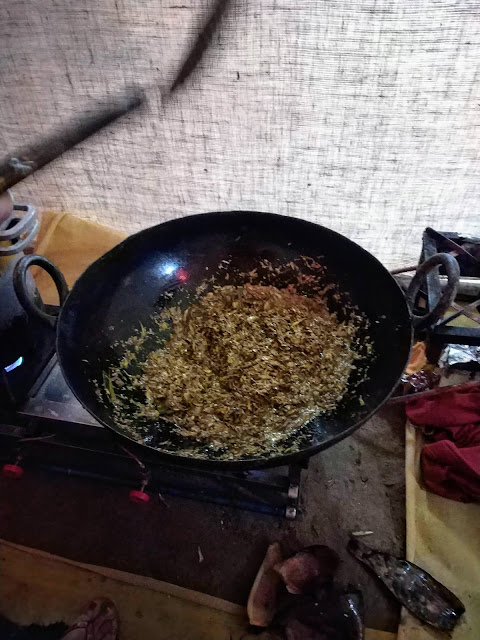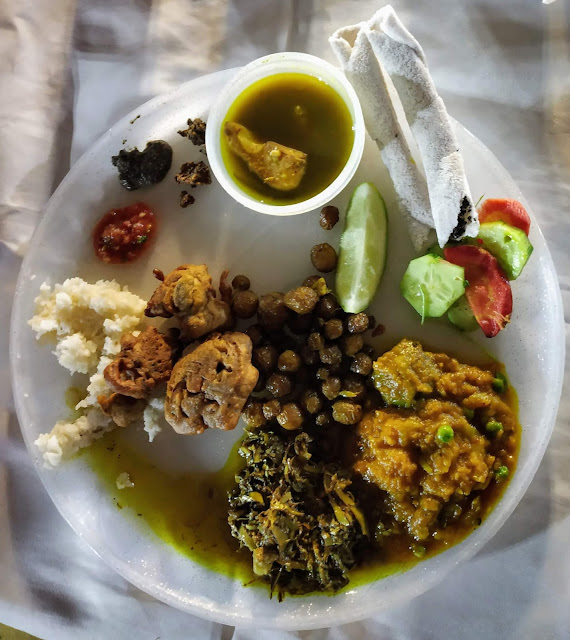LLDC 2019 – Part 3: The Assamese Kitchen
After my exploration of Manipuri food, I hopped over to the Assamese kitchen.
The Assamese kitchen, at the other end of the dining area, was run by a lady named Ms Lucky.
“We’re from the Ahom tribe in Assam”, Ms Lucky told me proudly (read more about this ethnic group here). She and her team cater for cultural events and festivals like this one, all over the country.
As dinner time drew closer, her Assamese team along with two local volunteers were buzzing about chopping large red pumpkins, cleaning banana flowers, and stirring a large boiling cauldron of sticky rice.
Although she preferred that I didn’t take pictures of her, she didn’t mind my looking around the kitchen as she busily fried a big kadhai of chopped banana flowers. Bananas are called kol, she explained, and the variety of banana to which these flowers belong as known as bheem kol.
 |
| Bheem Kol flower |
 |
| The cleaned and chopped Banana flower being fried |
A large pail was full of small redish-brown spheres, soaking in water.
 |
| Mysterious tiny globules |
Tiny potatoes, I was informed. (After some digging around, I’ve concluded that these might be badami aloo that Chef Kashmiri Nath mentions in this article).
Another fruit I was reintroduced to here was the elephant apple.
I say “reintroduced”, because as soon as I saw it, I remembered a time about 5 years ago when I had visited the Lalbagh Botanical Gardens in Bangalore. I’d come across this strange hard-shelled fruit. Curious, I tried to crack it open, first with my hands, then by throwing it on the grown, and then by standing on it with all my weight. Nothing seemed to work, so I gave up, accepting that I would never know what it was, or how it looked on the inside. But just like that, the five-year old mystery was finally solved. And I even got to taste it!
 |
| Elephant apple, with its hard shell |
Sour chunks of the fruit’s core were used in the dal that evening as part of the Assamese thali.
The meal:
 |
| A messy plate but a delicious meal! The elephant apple at 12 o'clock and the baby potatoes in the centre |
When it comes to food, I have one general rule that I live by: given the opportunity, try anything at least once.
I had to firmly remind myself of this rule, because the blob of bright red chutney sitting on my plate was made from one of the world’s spiciest chilies: bhut jolokia. I broke into a cold sweat, then told myself to suck it up, and dared to have only the tiniest smidgen of the chutney with my rice.
But I survived the experience, thanks in no small part to the long slice of lemon, known as kaji nemu, which was more fresh and citrusy than the mouth-puckering tartness I had expected.
My favourite item on this thali though were the tiny potatoes, no larger than plump peas, and fried with just some simple seasoning.
 |
| Just look at how tiny they are! |
With all these new North Eastern ingredients, and interesting conversations with the traditional chefs, I was almost forgetting which part of the country I was in.
Luckily, the Kutchi thali was next on my list – and it was a great segue into the rest of my Kutchi adventures that awaited!
Stay tuned for more on that…
Comments
Post a Comment
Would love to hear your thoughts :)